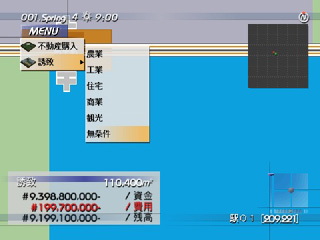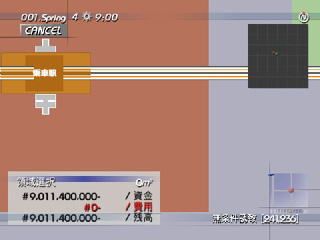|
 xero_one's "A-Train 2001" exploits xero_one's "A-Train 2001" exploits
The page has been translated through the English editor's
knowledge of the game, machine translation, and information from the website
administrator.
Please forgive any mistranslation.
Chapter 1 : Important points to consider before the
construction of a station (Beginner)
First of all, how does one increase the population ? The answer lies in our Industry
Points. In "A-Train 5" you could increase the population by building apartment
buildings. However, when it comes to "A-Train The 21st Century" (and, by the
same token, "A-Train 2001" on PS2) the situation has changed. The better the
balance of our Industry Points the faster our population will increase.
A minimum of 20,000 points is a good starting point for each industry. Commercial and
Residential points should be roughly similar, and when the conditions are met tourism can
be attracted. |
|
|
|
 |
|
Points to consider before the construction of a station.
|
|
|
|

1. Ensuring our industrial area is
sufficiently developed.
| Without a well developed industrial district it will
become difficult to procure the materials required for the later development of our
cities. The picture above shows an industrial district worth about 21,000 Industry Points
on its own. A situation can arise where the industrial district will construct many
garbage disposal plants and not construct large scale factories. However, this is only
cosmetic and does not have a negative effect on the production of materials. You should
not have to worry about garbage disposal plants. |
Return to Top
2. Picking a location clear from obstruction.
| Before constructing a station we need to check the surrounding area. If the location
is clear from obstruction, such as rivers and mountains, then the station will develop. If
a station is placed near an obstruction it will grow initially, however development may
cease with the message "Development is stagnant. There is no land suitable for
development." so be cautious. The distance required from an obstruction depends on
the type of industry being built. As a rough guide, industrial districts should be given a
50 tile radius, residential a 40 tile radius, and commercial a 35 tile radius from the
centre of the station. Agricultural development requires vast amounts of land so ensure it
has plenty of room for development. |
|
 |
Return to Top
3. Selecting the right station building type,
the freight station location, and train types to use.
| It is important to choose the right kind of station for the development you want. The
city/urban station is good for residential and commercial districts, suburban station for
housing and industrial, and agricultural districts, and country stations are best suited
for agricultural development. There are some exceptions with regards to tourism
developments which requires a connection to a large commercial district with roughly two
trains running in under 30 minutes. The type of commercial district station building does
not matter for attracting tourism as long as it has reached a stage of large development. The
table to the right is a rough guide. It is not 100% accurate as there are still things
that are unconfirmed. |
|
| Station Building |
Urban |
Suburban |
Country |
| Residential |
○ |
○ |
△ |
| Commercial |
Best |
△ |
× |
| Industry |
○ |
○ |
△ |
| Agriculture |
× |
○ |
Best |
| Tourism |
○ |
△ (× if small ground station) |
× |
|
|
|
|
Supplemental information from Tapioca regarding Tourism
As an example of tourism development: A tourism station constructed at a distance of 70
tiles from a large commercial district and at least 100 tiles from an industrial district
will develop. Both small and large country stations will not lead to tourism development.
Small suburban ground stations will not develop tourism, however large suburban ground
stations will. Raised suburban stations both large and small will develop tourism, and
city stations irrespective of size or type will develop tourism. However, if a compatible
ground type station is built and tourism has developed. The station can be changed to any
incompatible station and the tourism will remain. |
|
|
|

These station buildings are most suitable for attracting commercial and residential
development. Commerce does not develop well with suburban stations.
|
|

Country stations are best at attracting agricultural development. Surprisingly (?) the
"701 Series" trains suit agricultural development.
|
|
|
|
In the game there exists two station types, ground based
stations and elevated stations. Initially you may think there is no difference between the
two, but elevated stations take less land to build than their ground counterpart. For this
reason it is recommended that you build elevated stations. However, also be aware that the
cost of construction of elevated line is much higher than the cost of ground base line.
With agricultural development, ground type country and suburban stations are most
effective. Next is the matter of placing freight stations. As long as a station is within
range of the area of effect of a freight station then materials can be delivered. Although
it is possible to place a freight station next to a passenger station this is not
recommended because it hinders development. Rather, it is much better to place small
freight stations at either end of the line to encourage over-development. Also, as far as
industrial districts are concerned, if no large freight station is nearby then it will not
develop into a large industrial district. |
|
|
|

It is best to place freight stations on the outskirts of the city. |
|
On the topic of trains, commuter trains are desirable for connecting commercial and
residential districts. Also, if the number of passengers required to be transported is
large then they are perhaps also the best for the job. The "209 Series",
"E231 Series", and "Keio 8000 Series" are all recommended. At the
start of the game, since the number of people we need to transport is small, it's
recommended to reduce the number of cars in a train to lower running costs. I think that,
as far as agricultural lines are concerned, suburban vehicles are the most suitable
aesthetically. We recommend the "701 Series" (from the Train Kit expansion) that
can be assembled in a two car formation. For freight, the "EF210" is recommended
because it can be assembled into a two car formation (where most other freight trains are
a three car minimum). |
|
|
|

It's recommended to buy the "E231 Series" trains. Though the price is high they
generate large profit because the break-even ridership is low. Make them short in the
early game.
|
|

Using "EF210" freight trains is recommended because of their flexibility.
|
Return to Top
4. Selecting the development you want. (Large
commercial, residential, etc)
| Once a station has been built it is important to also
attract industries to the surrounding land. Attracting makes it easier for buildings to be
built and increases ridership. However, attracting a large area does not mean that
developing a large city will be successful or easy. If you attract a large area of
commercial at once then nothing but commercial buildings will be built. Eventually, as
building new businesses becomes limited, you may get the message "Development is
stagnant. There is no land suitable for development." The same applies to Residential
and Industrial attraction. To prevent this from happening it is important to limit the
initial scope of attraction. An estimated 15 tile radius from the centre of the station is
the recommended size. Residential and Industrial attraction may need a smaller area to
prevent stagnation if it happens to occur. Also, if you make a large area around the
station as an unassigned attraction then you won't have to pay more money later when
development takes off. In particular, commercial development leads to much higher land
values. |
|
|
|

First, create a large unassigned attraction area around the station.
|
|

For commercial this sort of attraction is the recommended size. Residential and Industrial
attraction should be slightly smaller.
|
Let's introduce a little technique.
| When building a new station, first create a large
unassigned attraction area around the station of about a 45 tile radius. After that,
attract the desired industry near the station centre. The order that you do this
attraction is important. If you first attract the industry then that will determine what
type of station it is to be and the price of the land around it will change accordingly.
For example, if you attract commercial first, then it will become a commercial station,
and when you try attracting on surrounding land the price rises sharply. On the other hand
if we do an unassigned attraction first, since the station does not know what type it will
be, the price will not rise. Since we have also bought the land, the cost of attraction
later will cost nothing. So, by using the unassigned attraction feature you can avoid
spending extra funds. |
Return to Top
 |
|
The information is based on the experiences and observations of xero_one.
Because of this, success is not guaranteed even when the steps are correctly followed. |
Noripyon made corrections and changes to various
places (2015/08/23)
Translated by Kresna (2016/11/11)
|
|